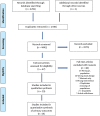Anatomical shoulder replacements in young patients: A systematic review and meta-analysis
- PMID: 37692879
- PMCID: PMC10492528
- DOI: 10.1177/17585732221075037
Anatomical shoulder replacements in young patients: A systematic review and meta-analysis
Abstract
Introduction: Increasing numbers of young patients receive shoulder replacements. Greater information on outcomes is needed to inform implant choice. The aim of this study was to investigate the survivorship and clinical effectiveness of hemiarthroplasty and anatomical total shoulder arthroplasty (TSA) in patients younger than 65 years.
Method: A systematic review was performed of MEDLINE, EMBASE, CENTRAL, The Cochrane Database of Systematic Reviews and National Joint Registry reports. The primary outcomes were implant survival and change in perioperative shoulder scores.
Results: Meta-analysis of implant survivorship was performed of six studies reporting on 416 patients. Implant survival was 86.1% (72.1,100) at 10 years for hemiarthroplasty and 82.3% (64.6,100) for TSA. 20 year survival was 80.0% for hemiarthroplasty (72.5,87.4) and 75.0% (56.9,93.1) for TSA. Ten studies were included in the meta-analysis of shoulder scores, multiple instruments were used. The standardised mean difference between pre-operative and post-operative shoulder scores was 2.15 (1.95, 2.35) for TSA at 4.2-4.9 years, and 2.72 (1.98,3.47) for hemiarthroplasty at 3.8-6 years.
Conclusion: Over 80% of shoulder replacements last more than 10 years, and 75% last more than 20 years. Significant improvements in shoulder scores are shown at all time points.
Keywords: arthroplasty; patient reported outcome measures; replacement; shoulder; survival.
© The Author(s) 2022.
Conflict of interest statement
The author(s) declared no potential conflicts of interest with respect to the research, authorship, and/or publication of this article.
Figures







References
-
- Williams BT, Beletsky A, Kunze KN, et al. Outcomes and survivorship after arthroscopic treatment of glenohumeral arthritis: a systematic review. Arthroscopy 2020; 36: 2010–2021. - PubMed
-
- Izquierdo R, Voloshin I, Edwards S, et al. Treatment of glenohumeral osteoarthritis. J Am Acad Orthop Surg 2010; 18: 375–382. - PubMed
-
- Garcia GH, Liu JN, Sinatro A, et al. High satisfaction and return to sports after total shoulder arthroplasty in patients aged 55 years and younger. Am J Sports Med 2017; 45: 1664–1669. - PubMed
-
- Bryant D, Litchfield R, Sandow Met al. et al. A comparison of pain, strength, range of motion, and functional outcomes after hemiarthroplasty and total shoulder arthroplasty in patients with osteoarthritis of the shoulder. J Bone Joint Surg Am 2005; 87: 1947–1956. - PubMed
Publication types
LinkOut - more resources
Full Text Sources
Research Materials
